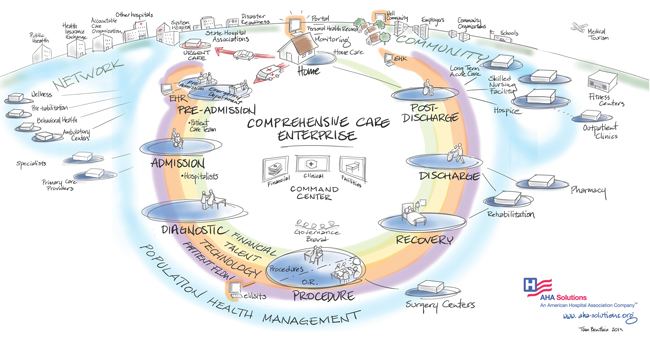The Changing Role of AHA Solutions Within the Comprehensive Care Enterprise
By Anthony J. Burke, Senior Vice President, American Hospital Association
and President & CEO, AHA Solutions, Inc.
America’s health care environment is undergoing sweeping change. Hospitals and other health care organizations are shifting their focus from their traditional fee-for-service, volume-based model to the outcomes- and value-based second curve.
Through collaboration and alignment with providers and partners outside the traditional four walls, health care organizations are endeavoring to transform the community’s sometimes fragmented health system into a continuum that integrates an organization’s payers and providers, the well community, ambulatory services, and acute and post-acute care.
AHA Solutions is calling this continuum the Comprehensive Care Enterprise — where care for an individual is coordinated and continuous, and is tracked and backed by integrated care pathways and supporting technologies. Overarching operational objectives include improving patient safety and quality outcomes through coordinated care with fewer financial resources.
As hospitals look to contain costs, comply with increasing regulatory pressures and protect reimbursement streams, they are extending their accountability for health by striving to proactively improve and protect the health of all members of the communities they serve. They may broaden programming to support the physical, social and emotional well-being of the individual. This often includes developing processes to assure smooth transitions, reduce the likelihood of readmission and improve information sharing for patients moving through ambulatory, acute, post-acute or wellness services, and while at home.
With these changes come new initiatives and challenges. Incentives are beginning to sway health care organizations’ interests toward offering programs that once were “nice-to-haves,” such as prevention, wellness and end of life. Health care organizations are using evidence-based practices and innovative means of engaging their communities, and they are discovering the importance of expanded patient engagement and improved patient experience. Through the Comprehensive Care Enterprise, population health management has quickly gained traction.
Changing Roles
The transformation in health care requires organizations to assess operational infrastructure both within and outside their walls related to the four cornerstones of patient safety and quality care, talent management, information technologies and financial systems, as well as population health management. Integral to achieving the second curve is an organization’s ability to align and integrate with providers across the Comprehensive Care Enterprise. Innovative partnerships are emerging and some organizations are acquiring synergistic providers. Such integration is important because the operational performance of one element of the Enterprise affects the performance of all.
To support the changing role of health care organizations and assist them in achieving the second curve, we at AHA Solutions are responding with our own changes. Our mission of fostering operational excellence in hospitals and our support for the four operational cornerstones remains unchanged. However, we recognize these platforms apply just as much to the flow of services outside the hospital as they do inside. We now look to foster operational excellence by helping health care organizations achieve success in the new era of health care.
A Conduit for Change
To help health care organizations achieve operational excellence, our strategy will identify solutions, inform and develop new Partners, and broaden our educational and peer-engagement reach.
As health care delivery moves toward medical home and accountable care models and other arrangements yet to be devised — and new challenges arise beyond the traditional hospital walls — numerous products and services will need to integrate across the entire Comprehensive Care Enterprise. In fact, the Affordable Care Act requires such integration and many hospitals are already seeking ways to achieve it.
By providing access to content experts and education, and by serving as the conduit to proven solutions that have earned the AHA Endorsement, we can facilitate decision making for services and products solving challenges across the Comprehensive Care Enterprise including in primary care, ambulatory care, short- and long-term post-acute care, and ancillary services such as labs and pharmacies. We will also strive to serve the field by performing as a conduit for understanding between the changing health care marketplace and our current and future vendor Partners.
As an extension of our educational and peer-engagement activities, each issue of this AHA Solutions newsletter will convey multiple perspectives on compelling challenges spanning the care continuum. These perspectives will help readers better understand the issues they share with other hospital departments and organizations, and the synergistic solutions their peers are using to successfully address those issues.
Change for the Better
We believe that as hospitals adjust their cultures to focus on second-curve transitional strategies such as support for population health improvement and the alignment of hospitals with clinical, social, employer, governmental and other community resources, American health care can only stand to benefit. We expect quality of care will rise, health outcomes of individuals and communities will improve, and overall care costs will fall. To help ease the shift for both hospitals and AHA Solutions Partners, we at AHA Solutions are stepping forward to lead the transformation to one aligned health care system.

